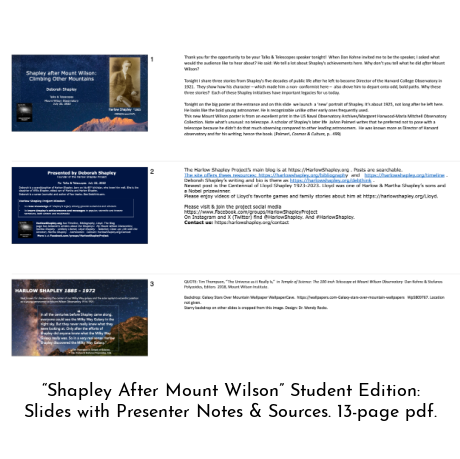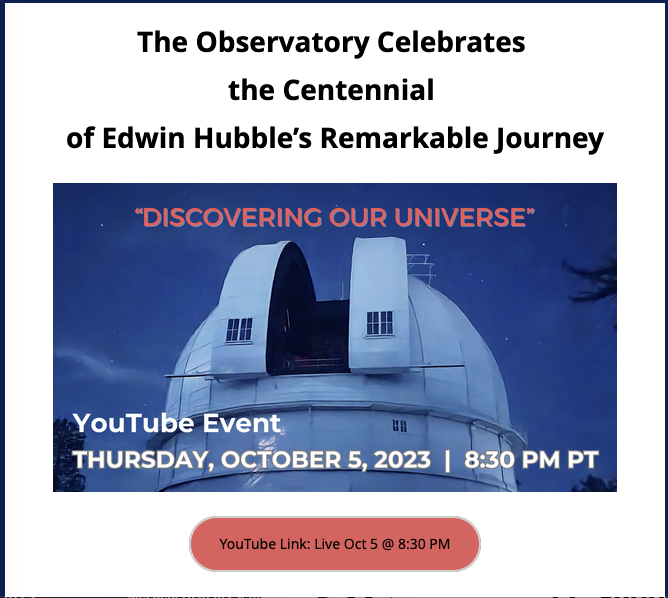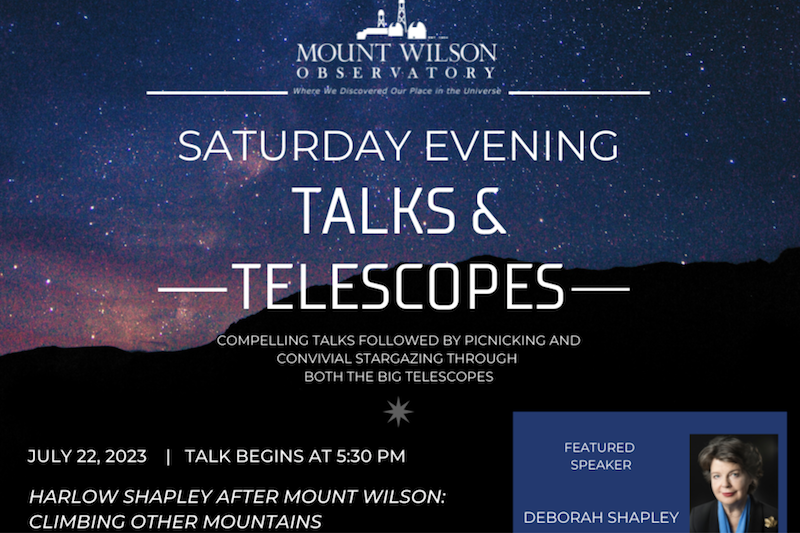The universe could have 100 million “life theaters” - planets that orbit in the zone of “the liquid water belt” around their stars - and thus “we are not alone.” This was Harlow Shapley’s scientific conclusion that he shared widely starting in 1953.
Shapley (1885-1972) was the most US famous astronomer of that era. Through most of the 1960s he laid out to audiences and readers the vision of a vast expanding universe abundant with life, including beings who are more advanced than us. At the time most scientists did not agree and the technology for exoplanet search was in its infancy.
”Shapley set the stage for the quest for life-bearing exoplanets which is the frontier of today’s astronomy,” said his granddaughter Deborah Shapley in a lecture July 22 at the Mount Wilson Observatory.
Her grandfather’s unconventional message about life in the universe was featured in Deborah’s lecture. She also told about two other challenges Shapley set for himself after he left Mount Wilson in 1921. As Director of Harvard College Observatory (1921-52) he added the role of newsman; thus he helped create the modern science press. In the 1930s and 1940s Shapley pushed to get jobs in the US for scientists fleeing the Nazis; his campaign rubbed against the grain of US immigration policy and most public opinion.
I. ThREE LEGACIES - Slides
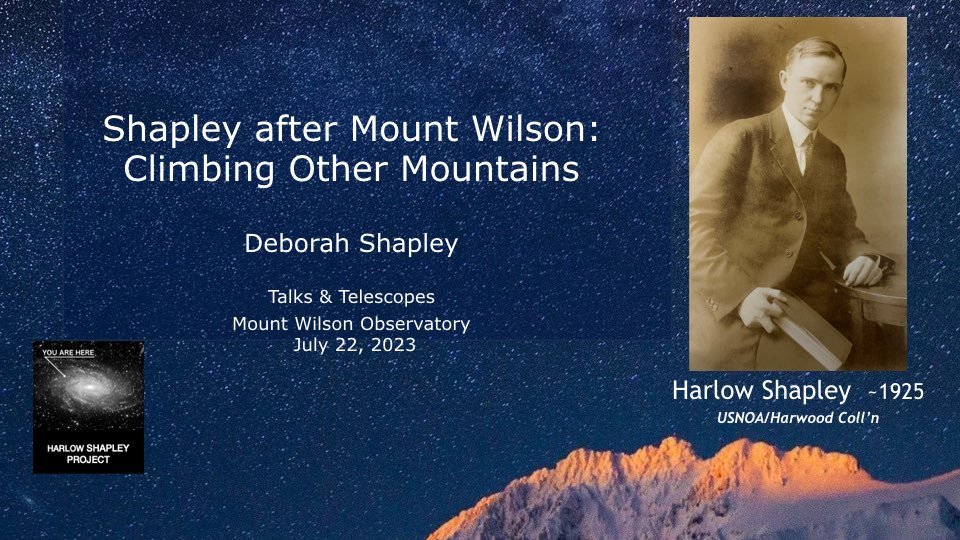

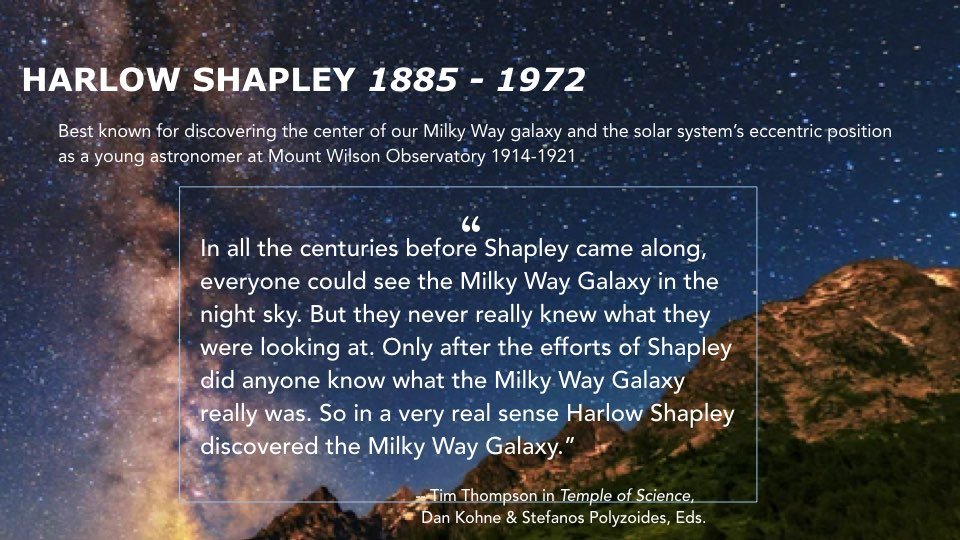
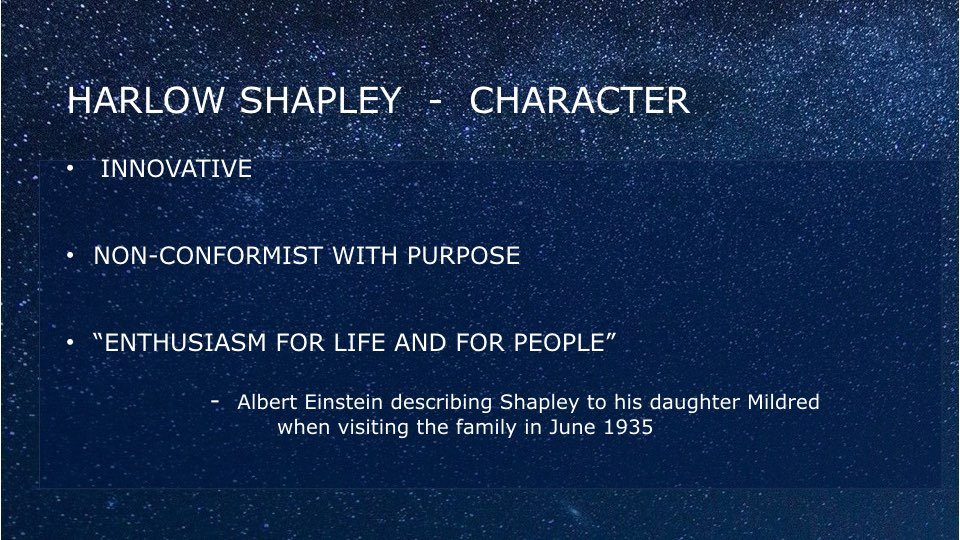
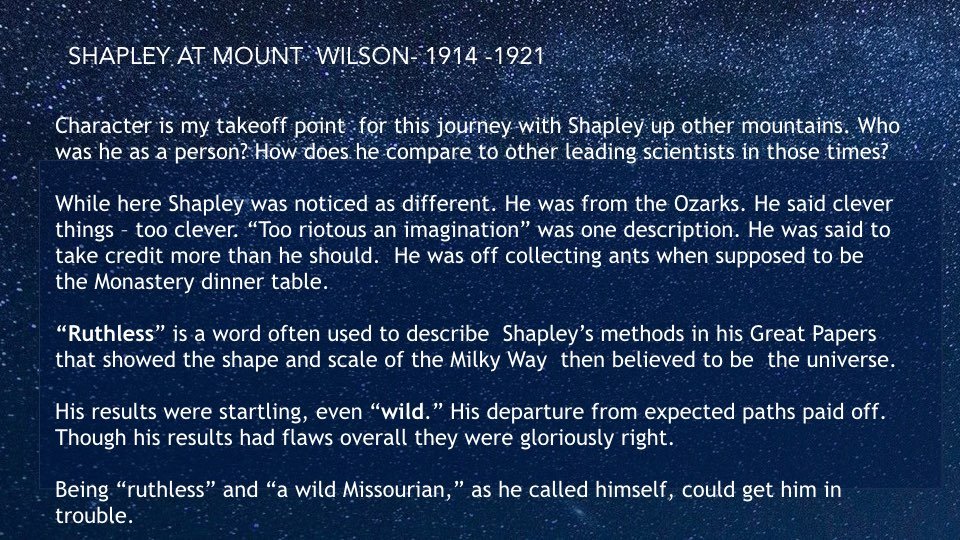
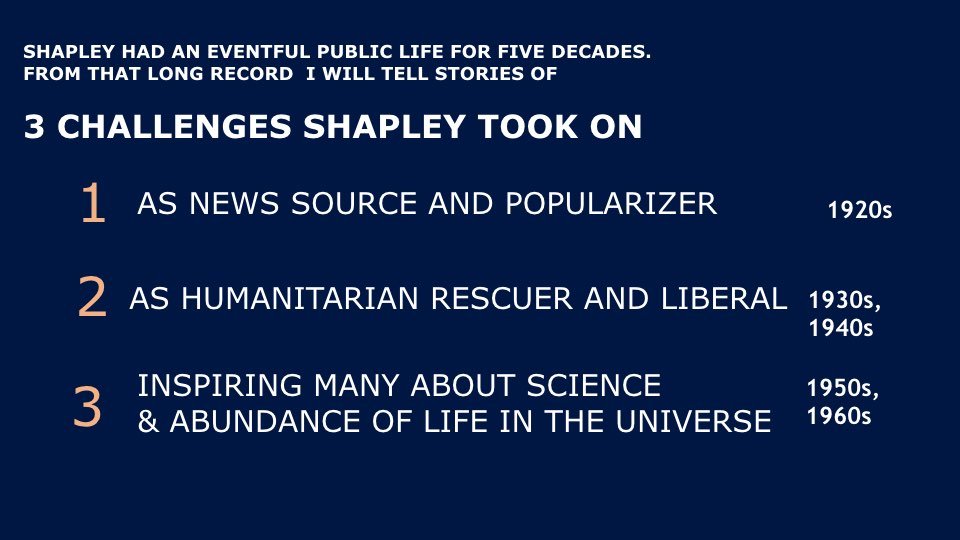
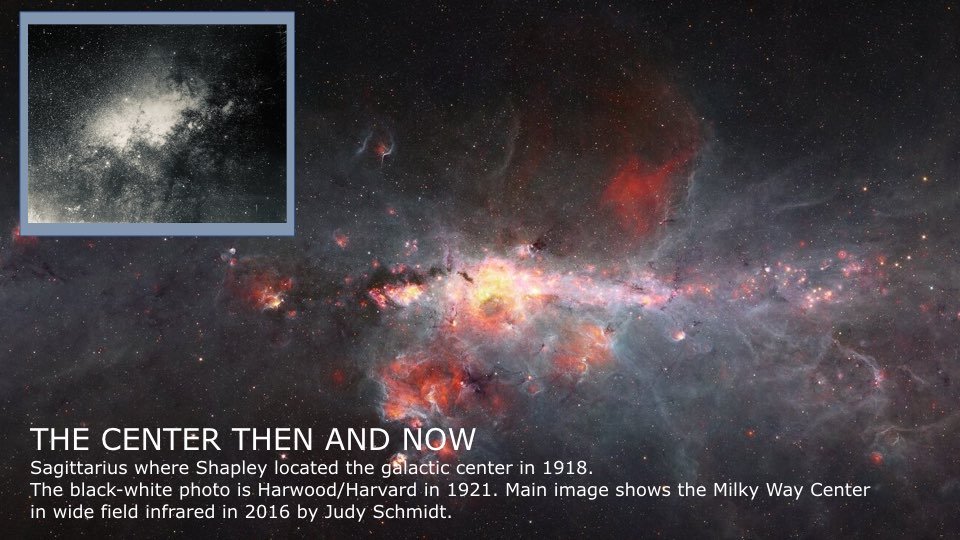
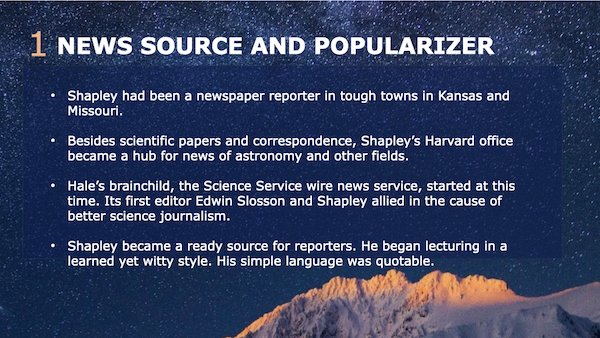
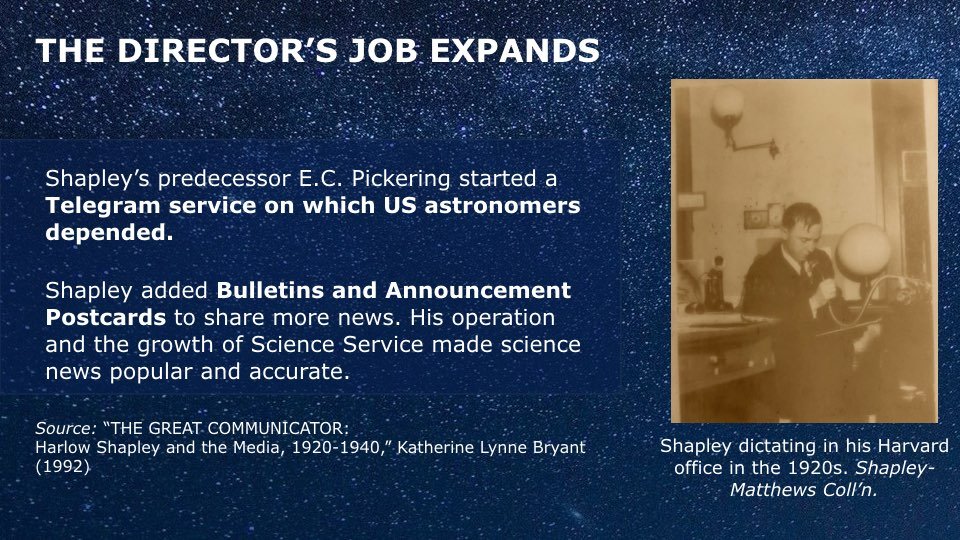
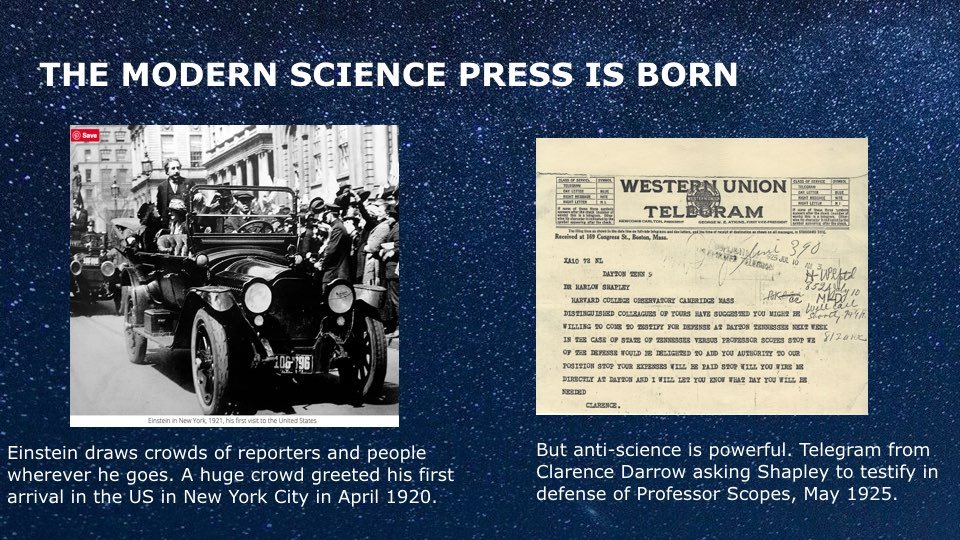
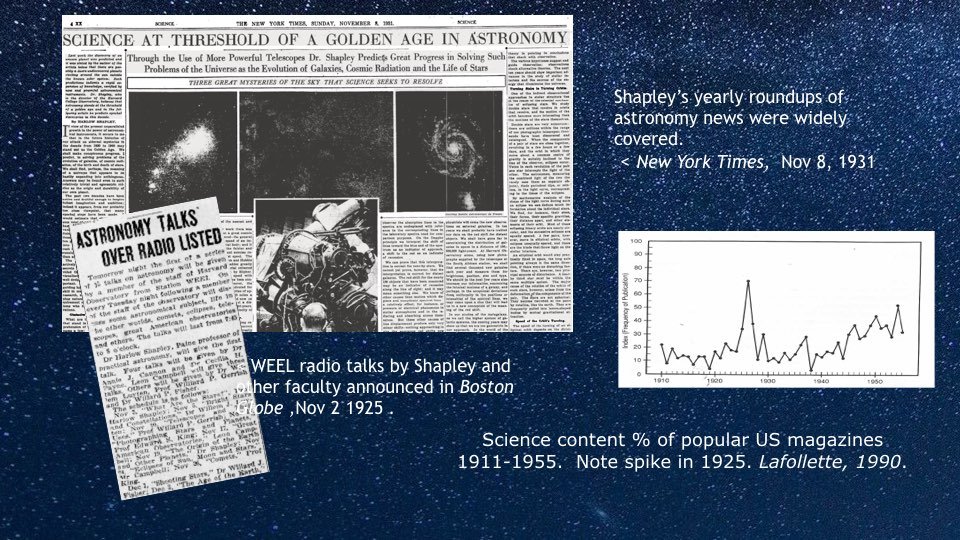
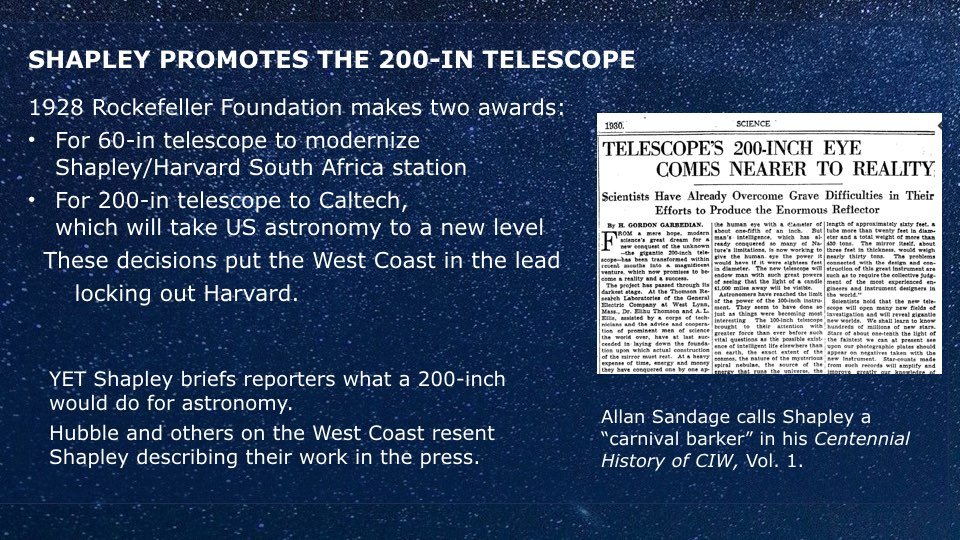


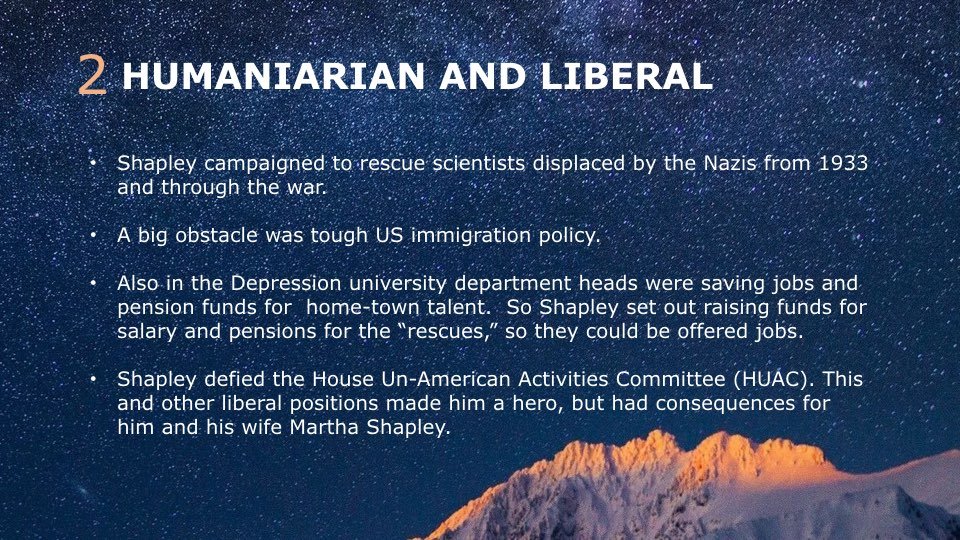
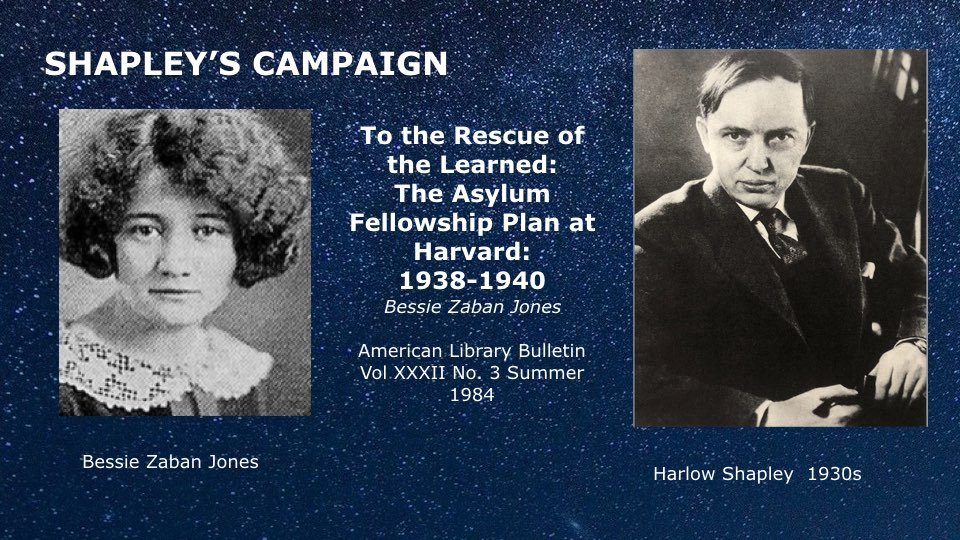
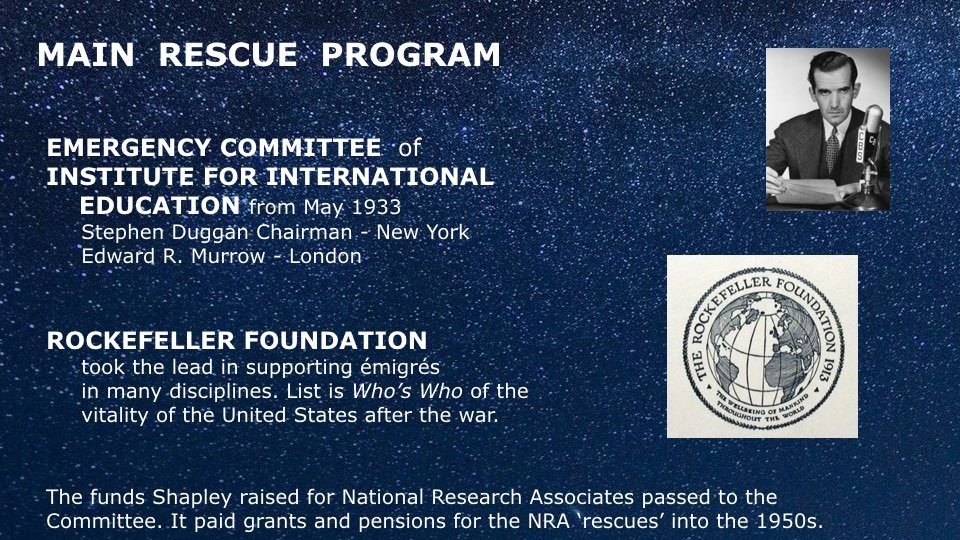
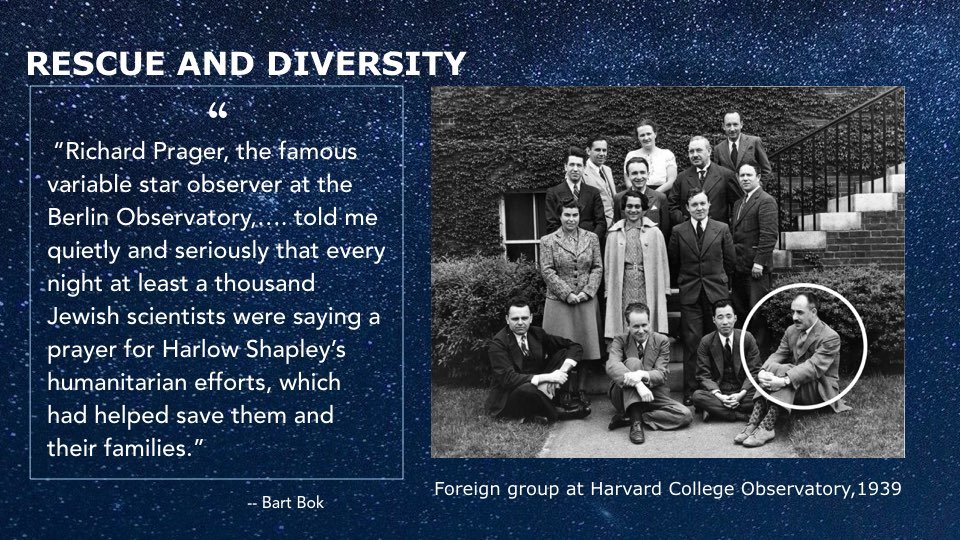
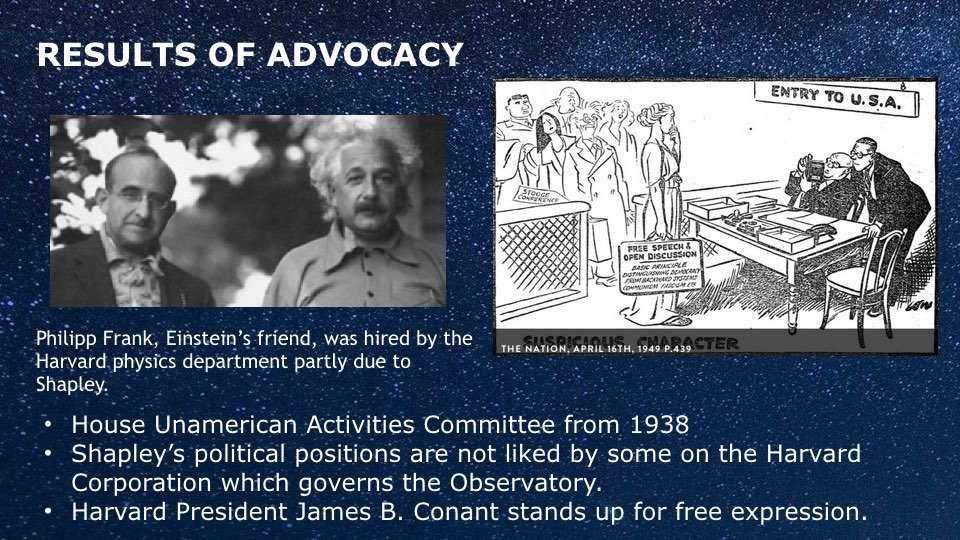
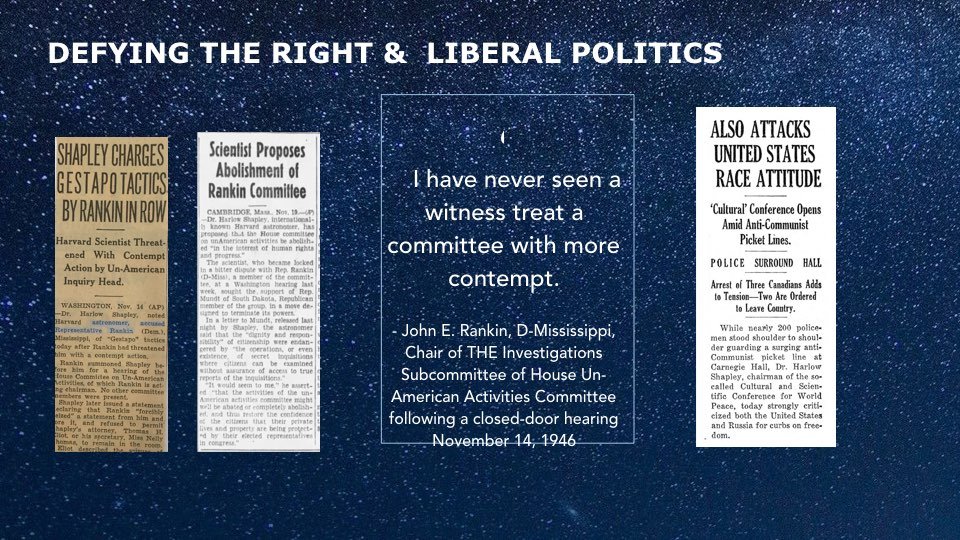
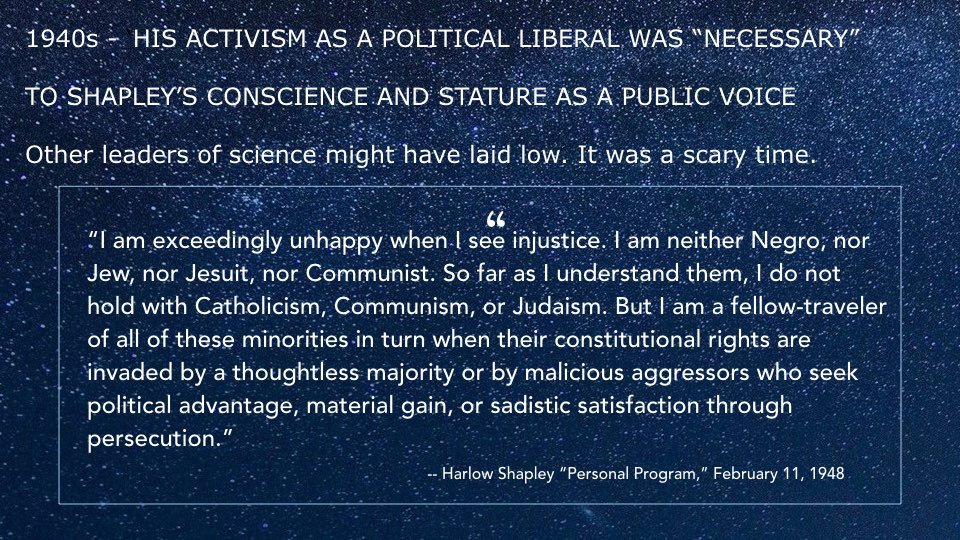
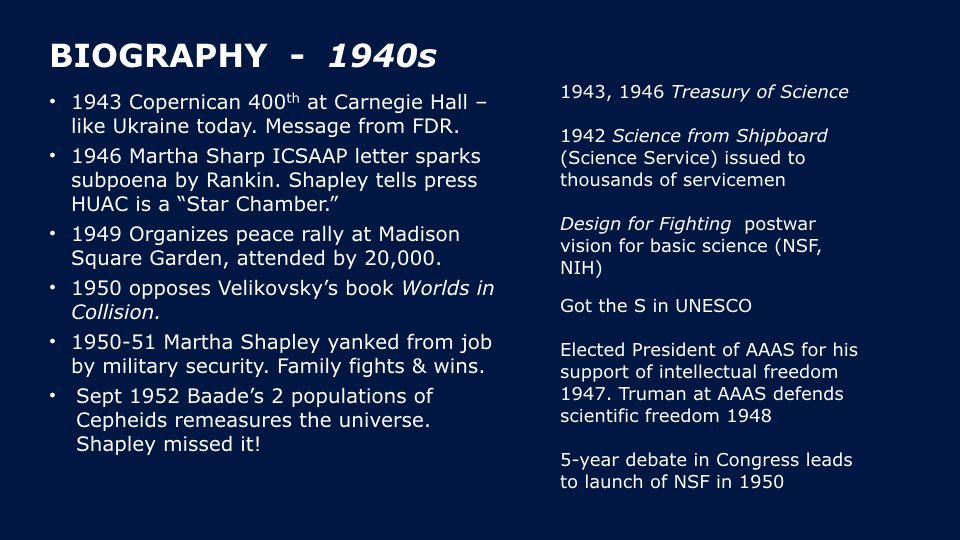
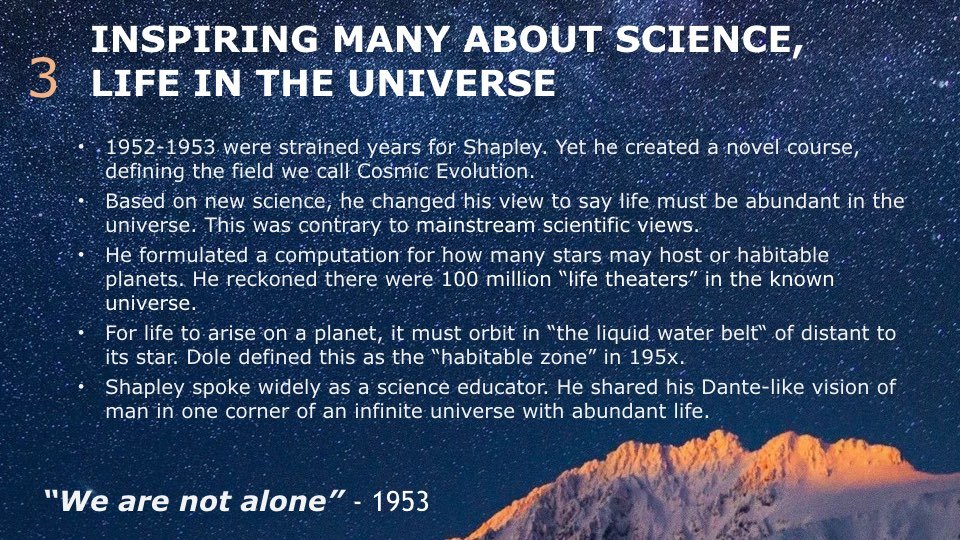
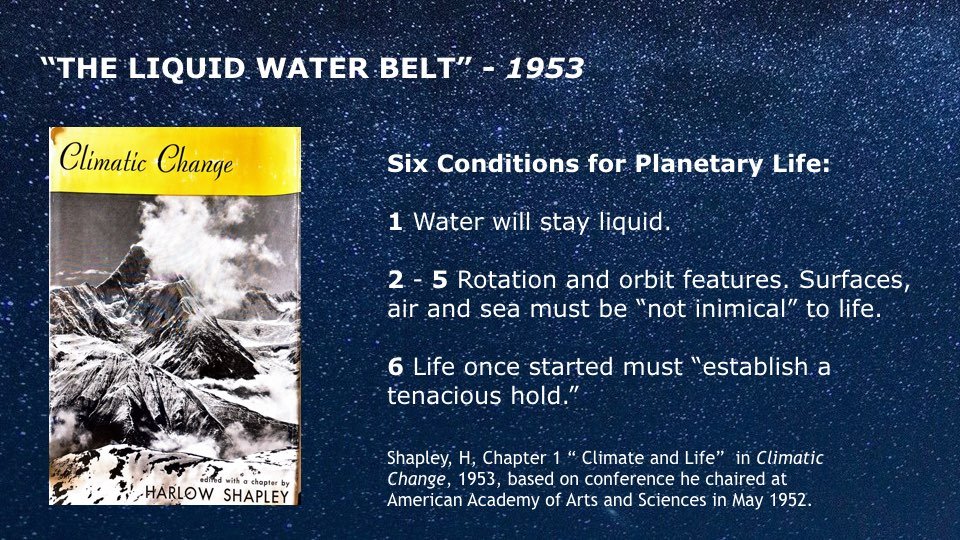

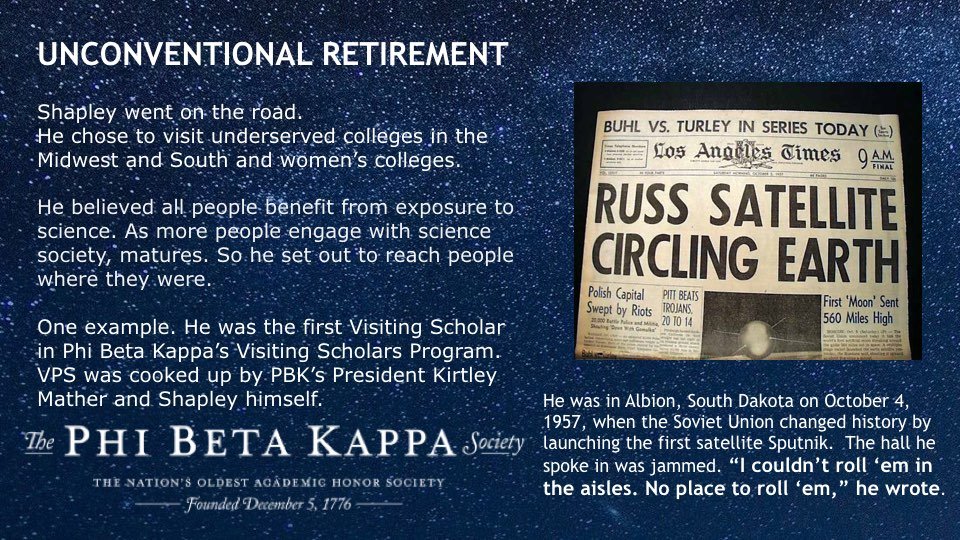
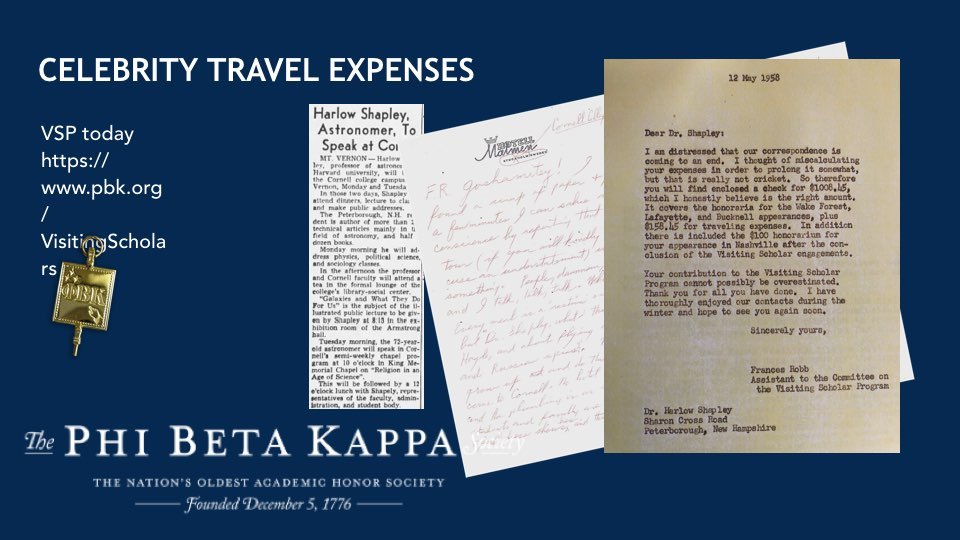
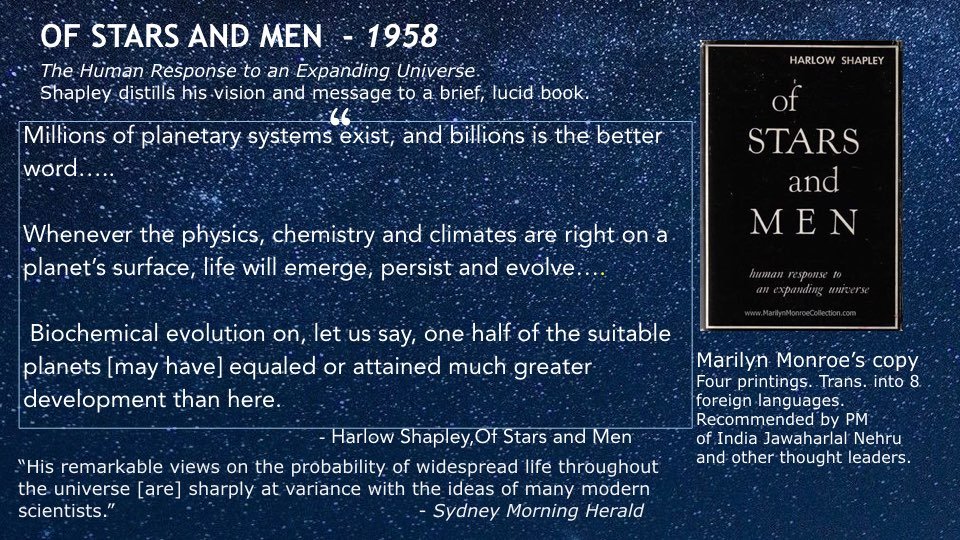
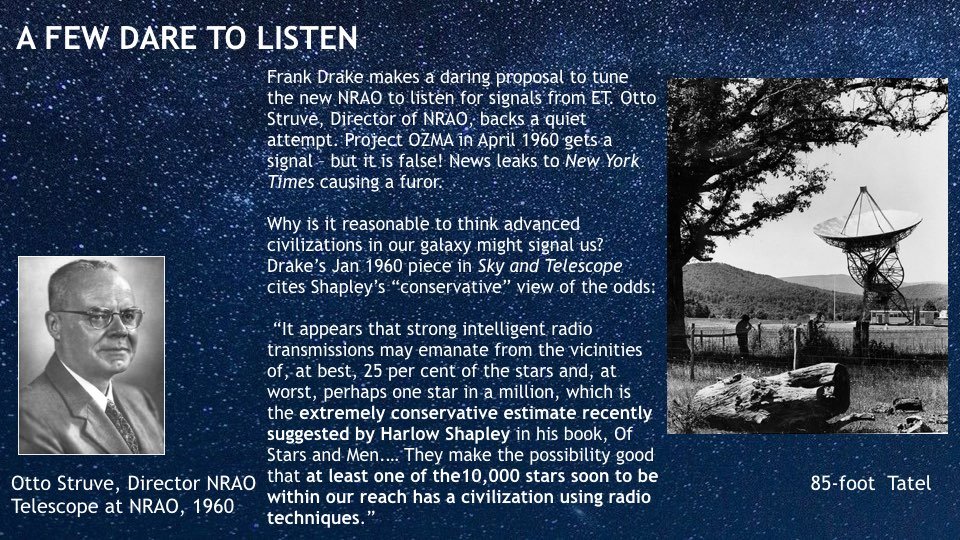
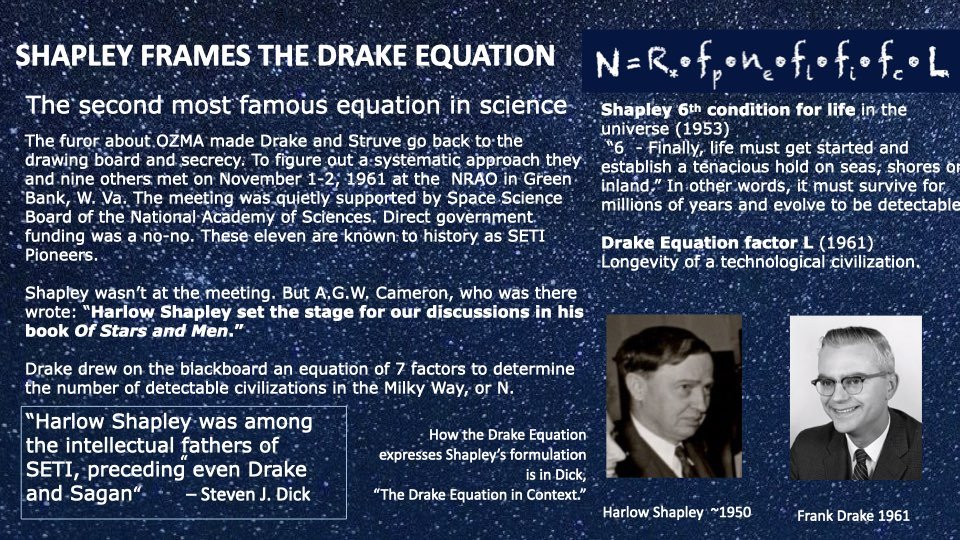
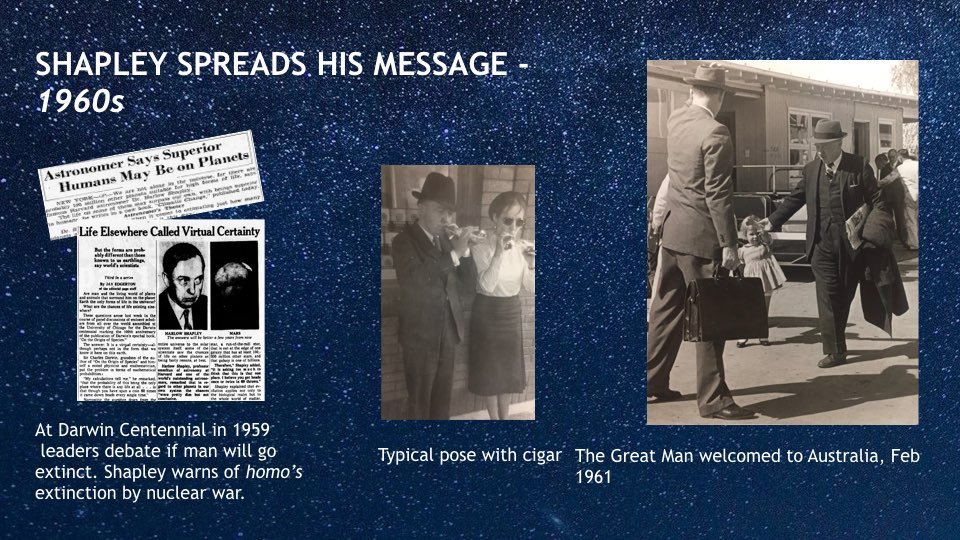
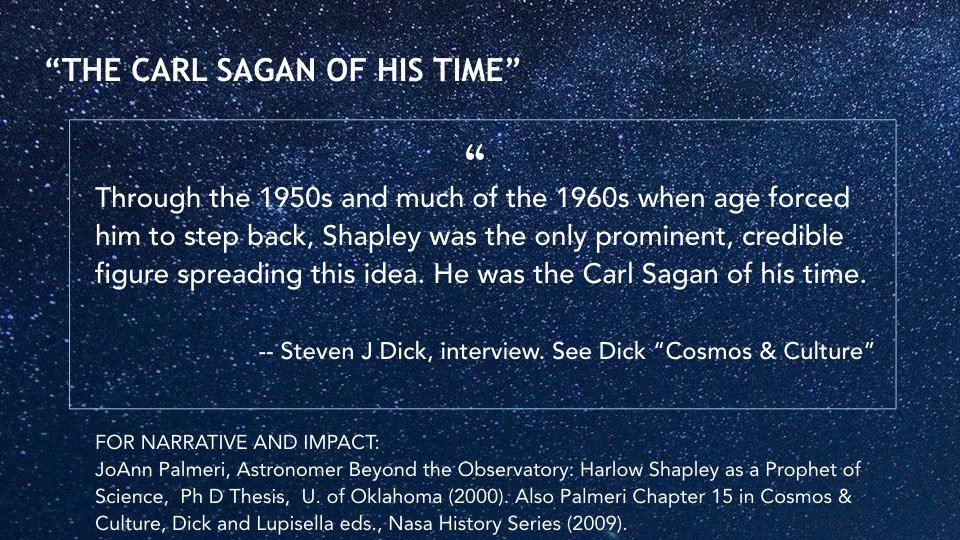
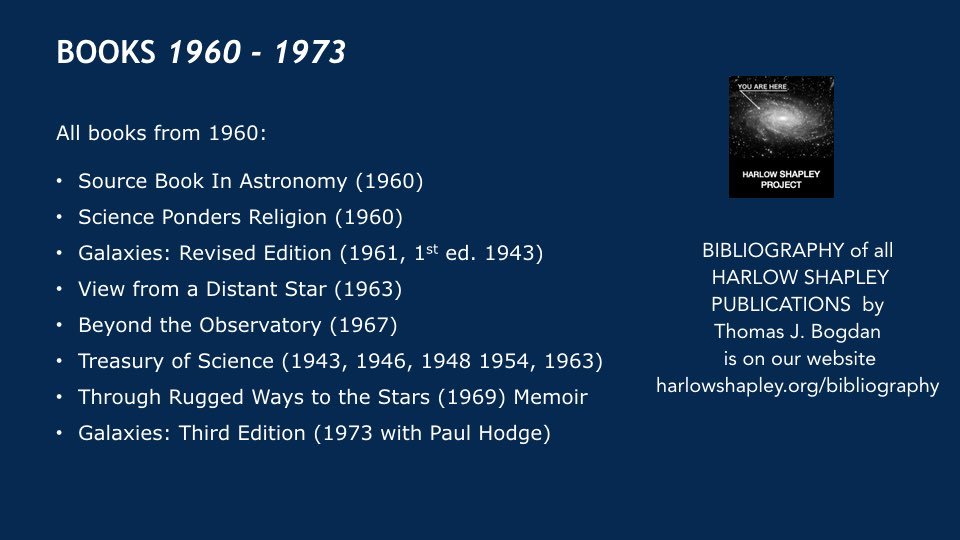
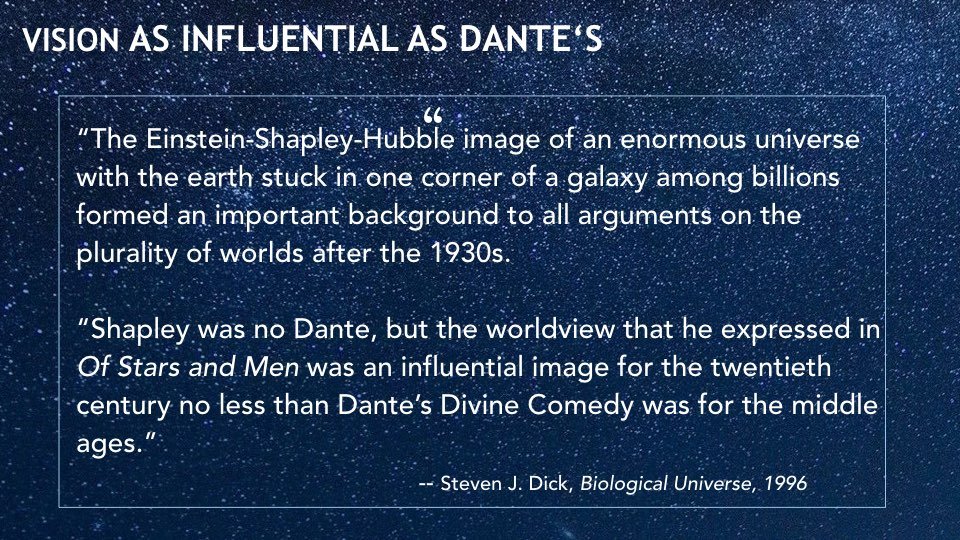


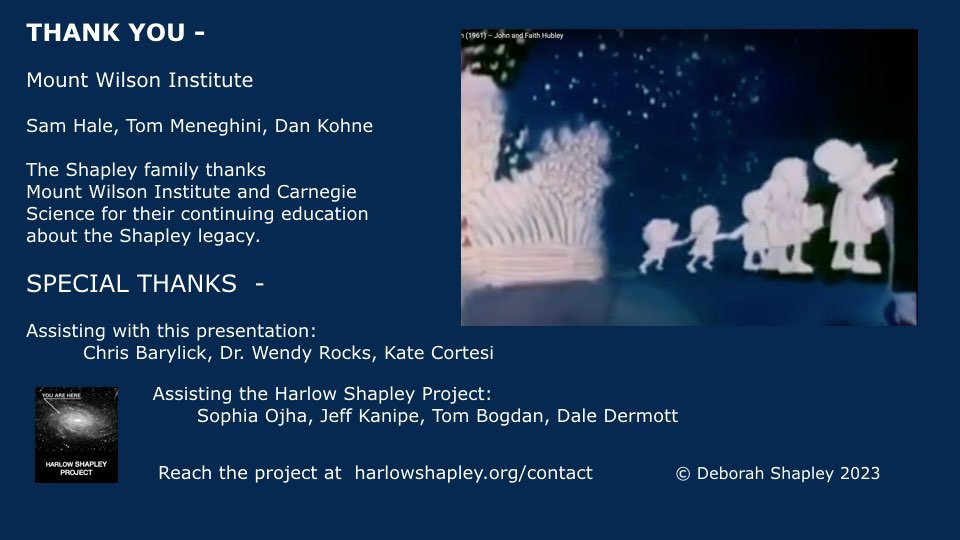
SHAPLEY AFTER MOUNT WILSON: CLIMBING OTHER MOUNTAINS
by Deborah Shapley
CONTENTS by Slide Number
Shapley & the Milky Way | Slide 3
Character & 3 Challenges | Slides 4-6
1 News source & popularizer | Slides 8-14
2 Humanitarian & liberal | Slides 15-22
3 Inspiring many about .. life on other worlds | Slides 23-34
Legacy | Slides 35-36
Lecture credits | Slide 37
Of Stars and Men Vid Clip 4:58 min | Shown at end of lecture
II. ThrEE CHALLENGeS HE TACKLED
While at Mount Wilson, Shapley showed “too riotous an imagination,” as one senior astronomer wrote. Deborah noted that Shapley’s attack on the scale of our galaxy - then thought to be the universe - required bold leaps that more cautious scientists might not have taken. Yet despite its flaws, Shapley’s discovery of the true galaxy center and our sun’s eccentric position was “gloriously right.” During five decades afterwards as a public figure Shapley took on other challenges not expected of scientists. Some of got him in trouble.
“Yet” Deborah told the audience: “I hope you’ll agree that by trying to conquer these ‘mountains’ Harlow Shapley left us great legacies today.”
1 - As News Source and Popularizer
“Shapley had been a newspaper reporter in tough towns in Kansas and Missouri,” Deborah said. “Besides scientific papers and correspondence, Shapley made his Harvard office into a hub for news of astronomy and other fields,”
George Ellery Hale’s brainchild, a science news wire service, was starting up when Shapley arrived at Harvard. The wire service wrote and distributed science articles to newsrooms so papers would print less “hocus-pocus.”
Shapley’s easy-to-grasp reports of the latest developments in astronomy and physics were carried in the press. Source: newspapers.com
Shapley wrote fast in an easy, simple style. In the 1920s the eloquence and wit of his lectures began to be noticed. Above from Lecture Slide 13.
“Science Service’s first editor Edwin Slosson and Shapley allied from 1921 on in the cause of better science journalism.” To the astronomical Telegram service Harvard ran for astronomers Shapley added descriptive Bulletins and Announcement Cards sent to astronomers and the press.
“Shapley’s operation and the growth of Science Service helped science articles to be more accurate and popular.”
Two events of the 1920s spurred the increase in science content in the popular press, Deborah said. One was the Scopes Monkey Trial of 1925 when a high school teacher in Tennessee challenged a state ban on the teaching of evolution. Deborah showed Clarence Darrow’s telegram to Shapley asking him to testify,
The other mega-event was Albert Einstein’s first arrival in the US in 1921. He was greeted by crowds and coverage. Then and on later visits the press treated Einstein as a revered emblem of science.
Harlow Shapley speaking into dictaphone in his Harvard office. Lecture Slide 9.
2 - Humanitarian & liberal
From 1933 and through the war, Shapley campaigned to rescue scientists needing to flee the Nazis. Deborah stressed he didn’t have to do this. By then he had a great position, his new astronomy graduate program, medals and so on. Yet he pushed boldly for a national asylum program that would follow Harvard’s lead; it came about only in a limited form.
Cartoon from The Nation, 1949, when Shapley made news trying to arrange “questionable” guests for a peace conference in New York.
Prager quote to Bok is Lecture Slide 18,
“The issue is not whether he succeeded in saving all the great scholars he wanted to,” Deborah said.
“The issue is: Compared to what? To whom? Which leaders of US science institutions took the risk of pushing for job offers for foreigners, many of them Jewish, in the face of strict US immigration laws and general prejudice?”
Deborah described Bessie Zaban Jones, the child of Jewish immigrants, who wrote the only detailed account of Shapley’s “rescue of the learned” published in 1984. She quoted Richard Prager saying “at least a thousand Jewish scientists” were grateful for Shapley’s efforts. (In his memoir Shapley wrote “about a hundred came across my desk.”)
Bessie Zaban Jones. Lecture Slide 16. Photo: Find-A-Grave
Jones quoted Shapley’s lighter efforts. One evening he wrote: “Tonight, as it happens, the wife of professor Philipp Frank is teaching about 30 of the Observatory people Hungarian folk dances in my home.”
Shapley defied the House Un-American Activities Committee (HUAC) in a famous 1946 fight with Mississippi Congressman John Rankin. This and his liberal politics in the late 1940s made him a hero, but had consequences for him and his wife Martha Shapley.
The FBI began following him in 1946. (He did not know this.) Actually Shapley had no past or current communist inferences, unlike for example Robert Oppenheimer, Deborah said. “Shapley’s political positions were not liked by some on the Harvard Corporation which oversees the Observatory.”
3 - Inspiring Many About Science, Life in the Universe
In 1952-53 as Shapley retired as Director he created a Harvard course that combined disciplines in the field now known as Cosmic Evolution. “Shapley responded fast as a scientist” when Stanley Miller’s experiment showed how living organisms could have arisen (See illustration). In a 1953 book Shapley “laid out six conditions for planetary life.” The first was “the liquid water belt” of distance a planet must have from its star. This “test - also called the habitable zone test - has been applied since in the search for exoplanets that could host life,” Deborah said.
From Lecture Slide 23
From Lecture Slide 32
Shapley’s formulation of the odds of a given star hosting a life-bearing planet was cited by astronomer Frank Drake (pictured) in his January 1960 article proposing the radio telescope at Green Bank, W.Va, be tuned to listen for signals from advanced civilizations.
Drake and many others quoted the conclusions Shapley expressed in a short poetic book Of Stars and Men, first published in 1958. It was a surprise hit.
After Deborah played a brief clip from the animated film Of Stars and Men, the audience applauded. (Vid Clip in Contents.)
Harlow Shapley ca 1950 and Frank Drake, 1961. Lecture Slide 30
Deborah adds, “With the rise of Carl Sagan as the public champion of SETI Shapley’s contribution largely dropped from view. It is rarely mentioned today.”
Legacy
The quotes on Deborah’s final slide “Legacy” led off with astronomer Bart Bok comparing Shapley to Copernicus.
The last quote was from the secret report of the FBI in 1953, when agents gave up finding anything. Shapley is
“…one of the supreme egotists of our time. He has an inherent dislike for authority, and will invariably do the opposite of what he is told or supposed to do.”
The Mt Wilson audience heard Shapley himself say the poetic closing Of Stars and Men, in a Video clip at the end of her lecture and applauded.
Harlow Shapley ca 1960 during the filming of Of Stars and Men. Photo: AIP/ESVA
III. EVENT SNAPSHOTS
Deborah Shapley presented “Shapley After Mount Wilson” to a full auditorium near the 60-inch Hooker telescope where her grandfather made his great discoveries. As night fell ticket-holders lined up to enter and view real stars through the 60-inch and 100-inch telescopes. The evening event was part of the Talks & Telescopes monthly series.
“We had an unusual number of visitors to the 60-inch, maybe because of the Shapley gestalt that evening,” Mount Wilson Institute Trustee Dan Kohne said afterwards.
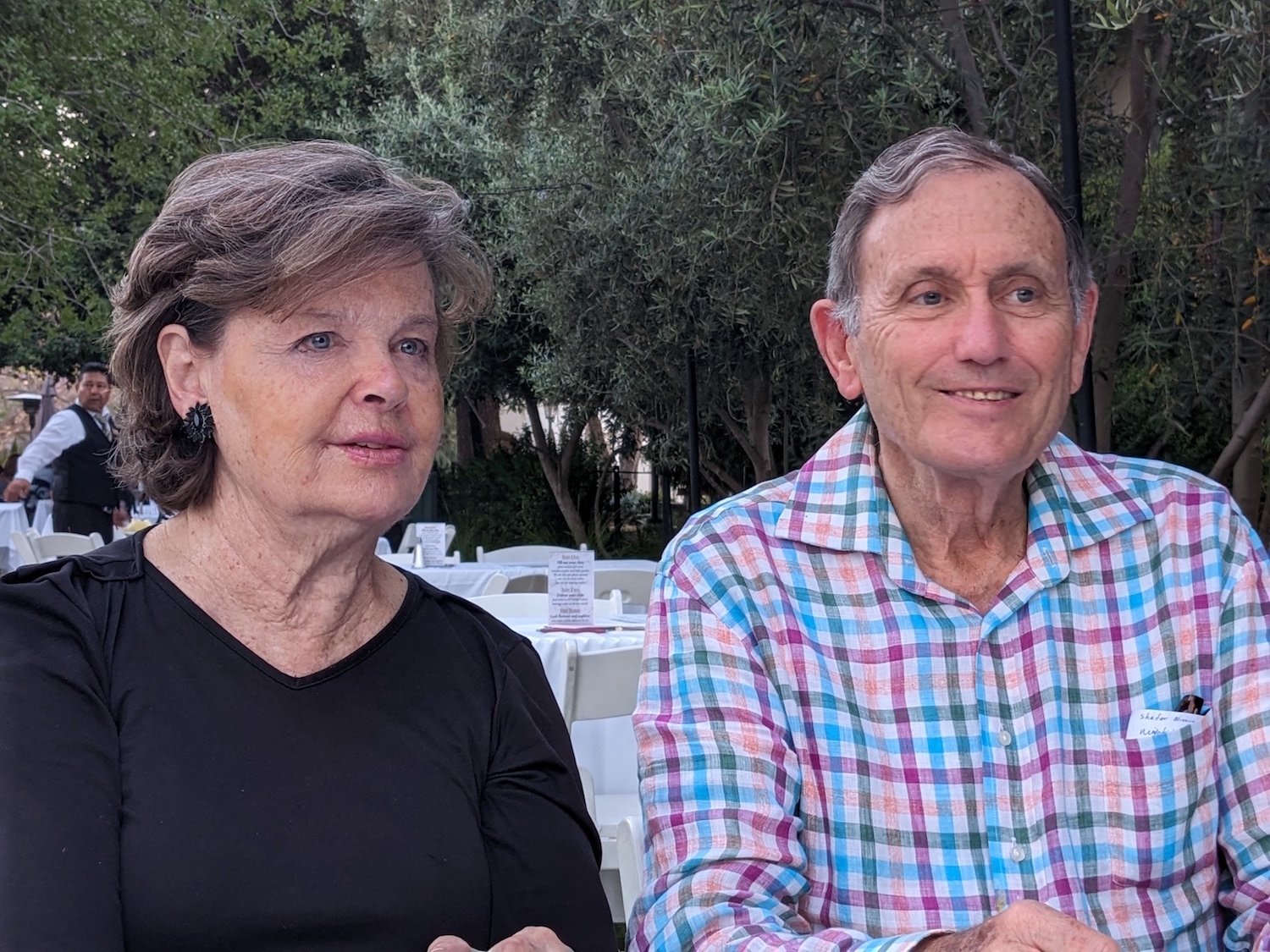
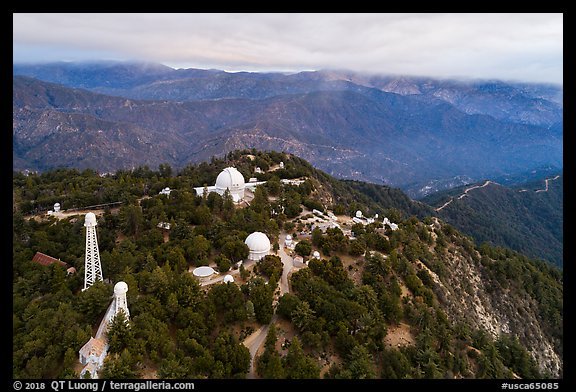

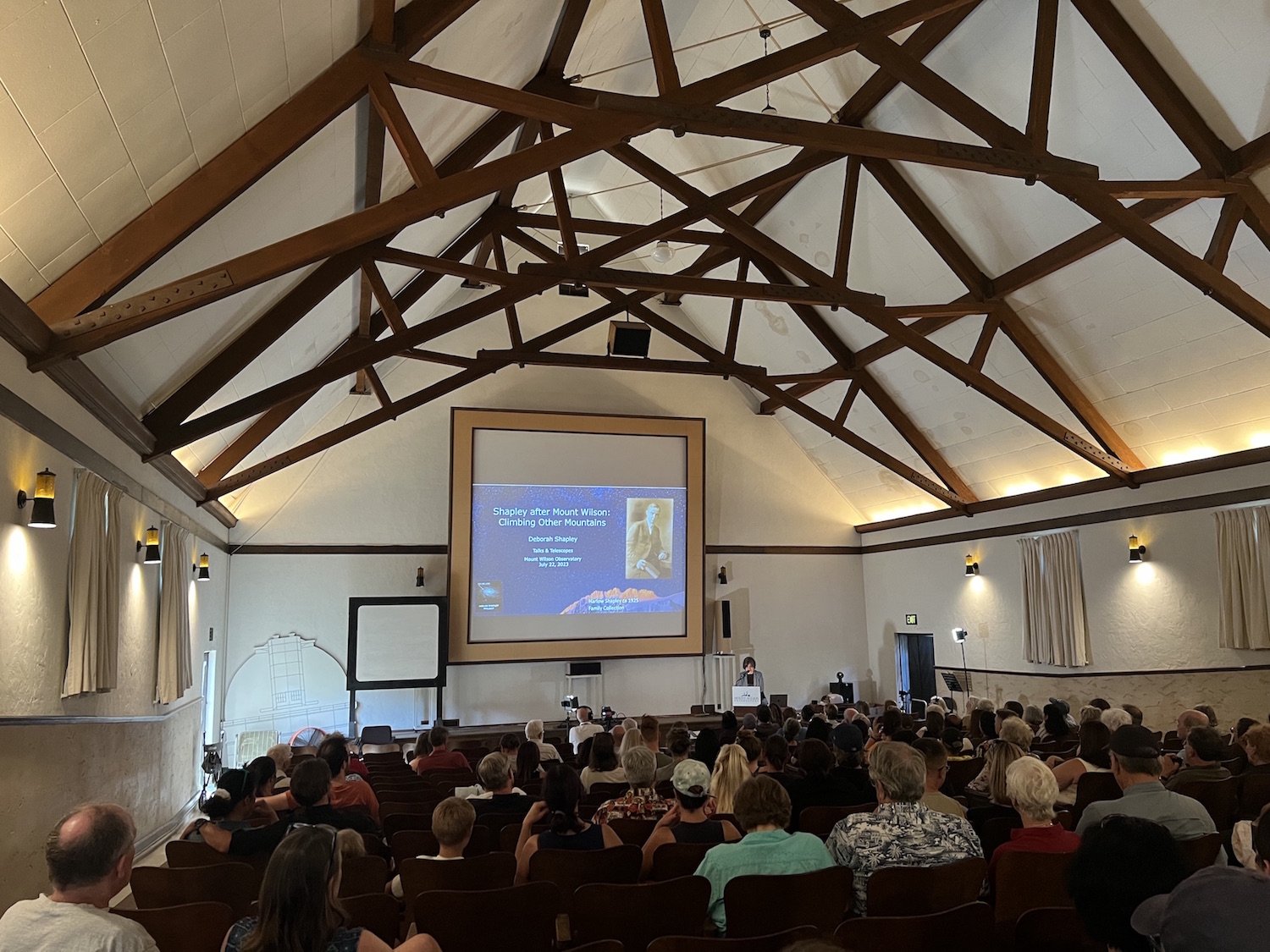
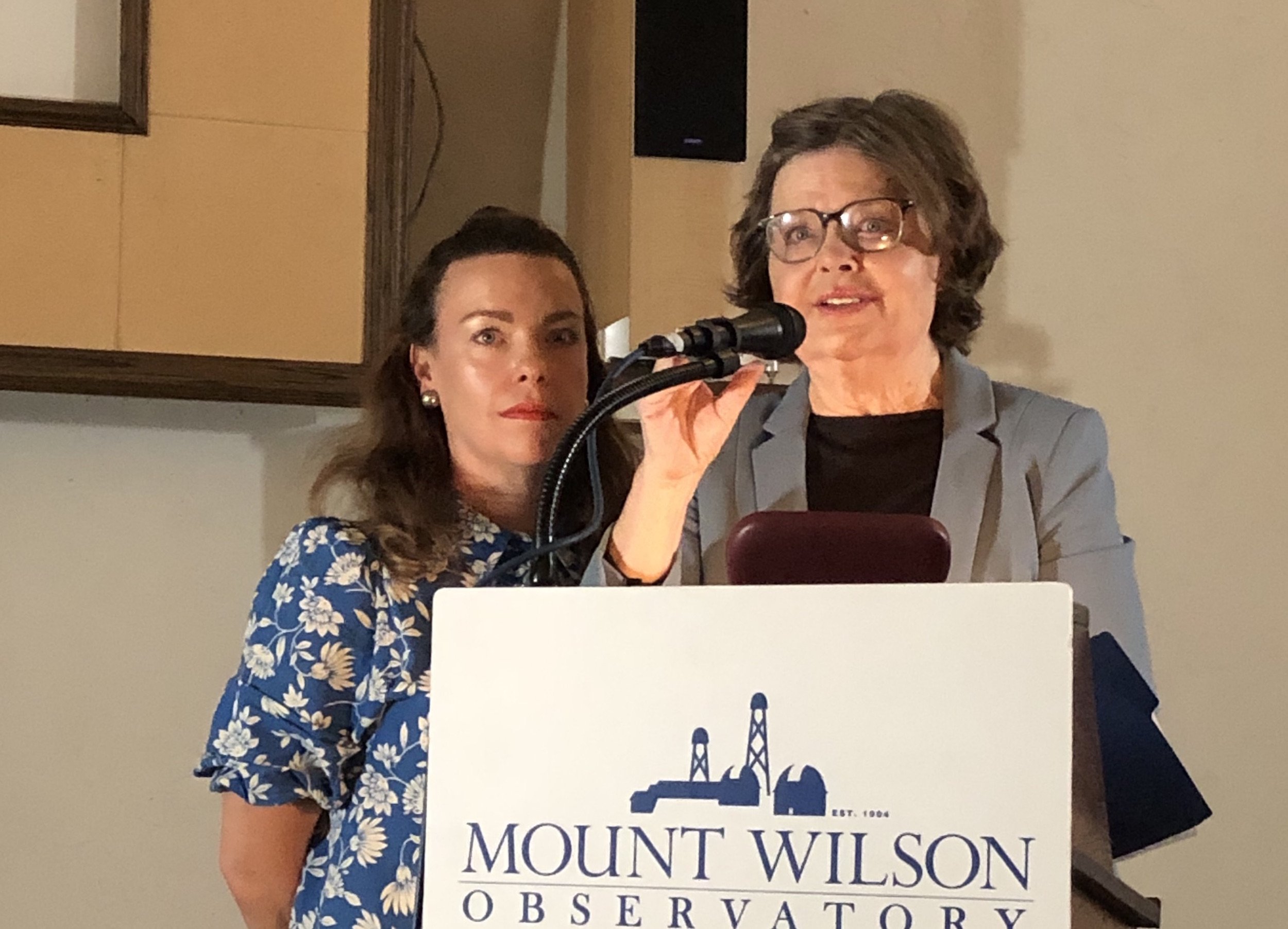
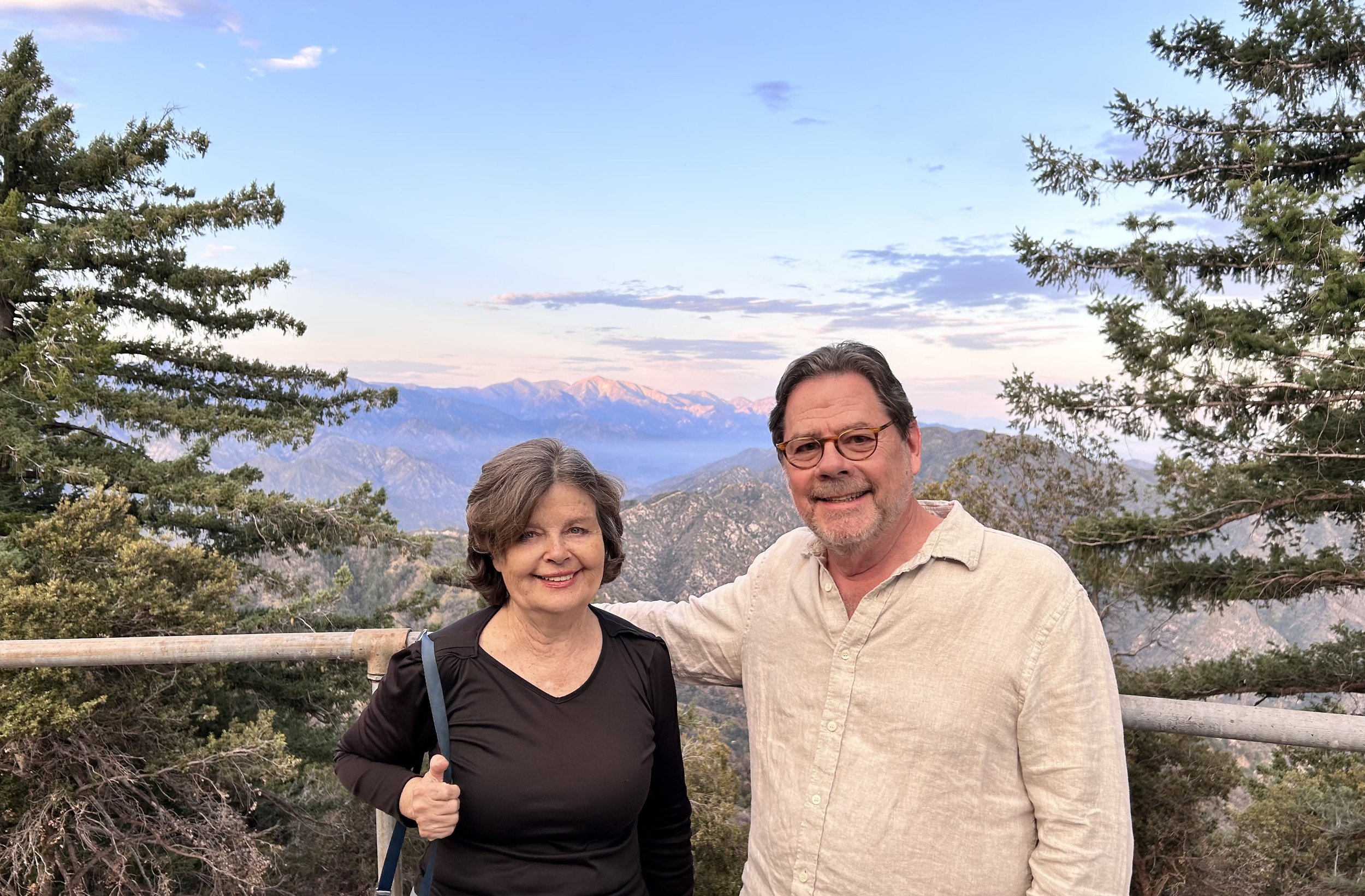
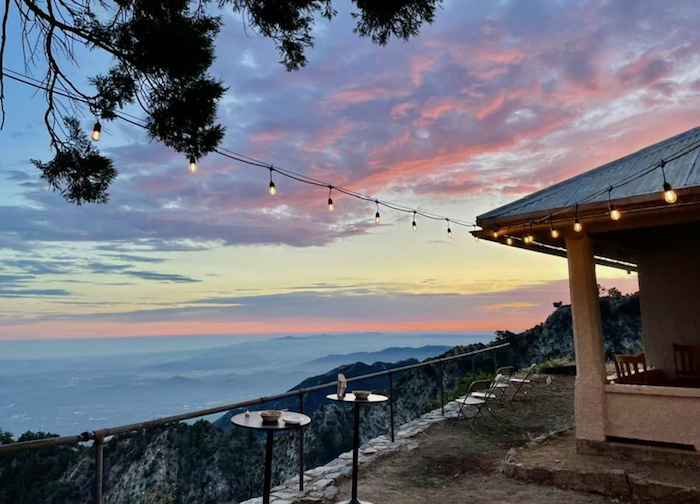
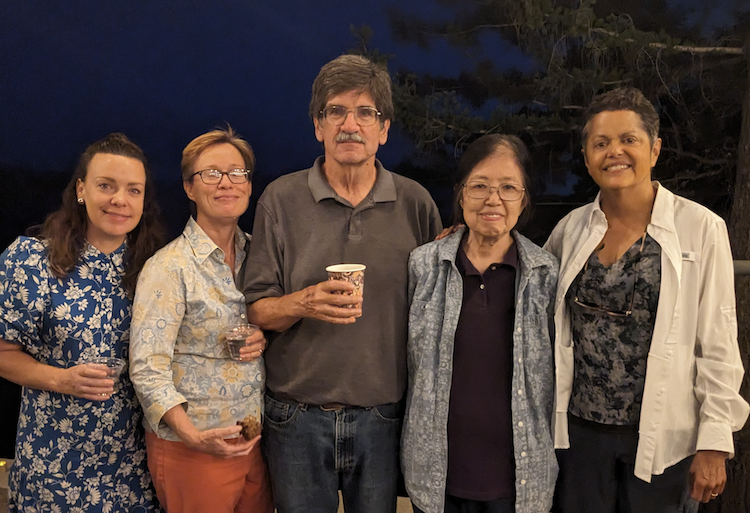
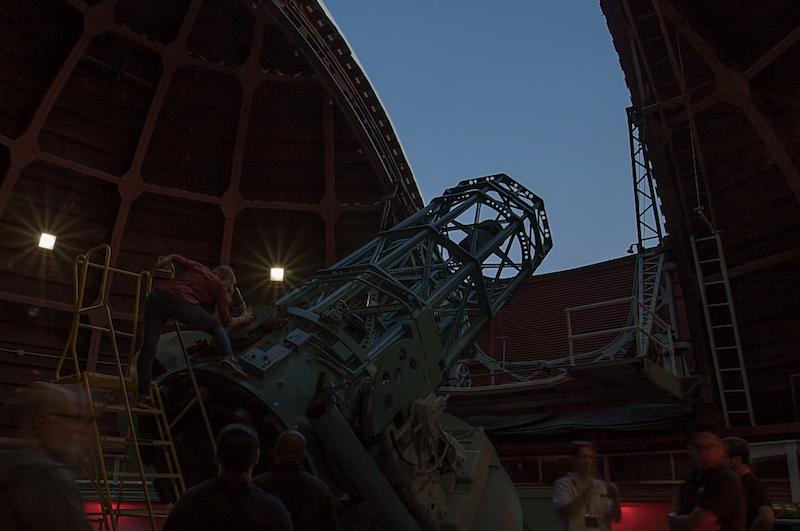
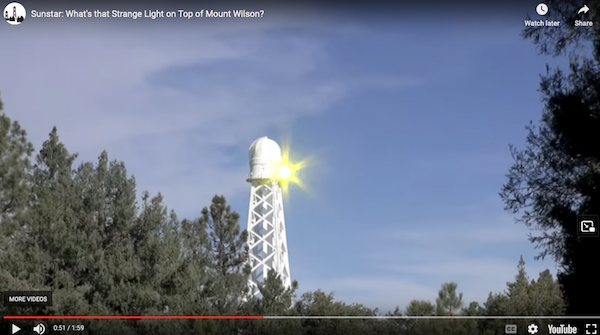
Mount Wilson Institute extended its hospitality to members of the Shapley family and guests for the event. Above the first image shows Deborah Shapley, lecturer and principal of the Harlow Shapley Project, with Samuel D. Hale, Chair of the MWI Board and grandson of George Ellery Hale, the visionary astronomer who created the observatory.
Other images: The mountaintop from the air; new portraits of Harlow and Martha on display; the auditorium as the lecture started; Deborah’s daughter Kate Cortesi assisting. Also shown are Jeff Kanipe who advises the project and Shapley cousins: Peter Shapley, son of Lloyd Shapley, his wife Feng-hsi Liu, Shapley granddaughter Martha Matthews and her wife Yolanda Vera.
We’re grateful to the institute for hosting family and guests for dinner and overnight at the Monastery - as if we were early 20th-century scientists! We loved the delicious dinner with a 1918 menu prepared by Sarah Emery Bunn. The final image is the SunStar prism art installation on the solar telescope tower.
IV. NEW SHAPLEY PORTRAITS
Harlow Shapley ~ 1925
Preparing for the July event, we searched for an early image of Harlow Shapley that looks like him. Deborah and her cousins - who knew him - have searched albums and collections for a good early photo.
This fine-quality print of Shapley taken in the 1920s is in the collection of Margaret Harwood. She was an astronomer at Harvard College Observatory and Director of the Maria Mitchell Observatory on Nantucket. This image is by permission of U S Naval Observatory Archives, which has Harwood’s photos.
We feel sure Harlow and Martha Shapley would approve the use of such materials and the 60-inch telescope itself to advance education and public knowledge today.
Harlow Shapley ~ 1925 Portrait. USNA Archives, Harwood Collection. Lecture Slide 1
Women at Mount Wilson
Martha Betz Shapley 1929 by Bachrach. From Shapley Collection.
Martha Betz met Harlow Shapley when they were students at the University of Missouri. They were married April 15, 1914 at her family home in Kansas City, Mo. and went west for him to start work at Mount Wilson. They lived in Pasadena seven years. In that time Martha gave birth to three children. As an unpaid ‘volunteer’ Martha wrote or co-wrote 14 astronomical papers.
On this blog please see Martha Shapley - Astronomer for her role in his early work and at Mount Wilson. Around the observatory you may see this photo. The family has allowed its use to illustrate the stories of women there.
V. UPCOMING ON THE MOUNTAIN
Talks & Telescopes
October, 5th 2023 | 8:30 pm PT | YouTube Event
The Observatory Celebrates the Centennial of Edwin Hubble’s Remarkable Journey
See Live Event: https://www.youtube.com/@mtwilsonobservatory
Deborah Shapley’s Talk July 22, 2023 - Notice
